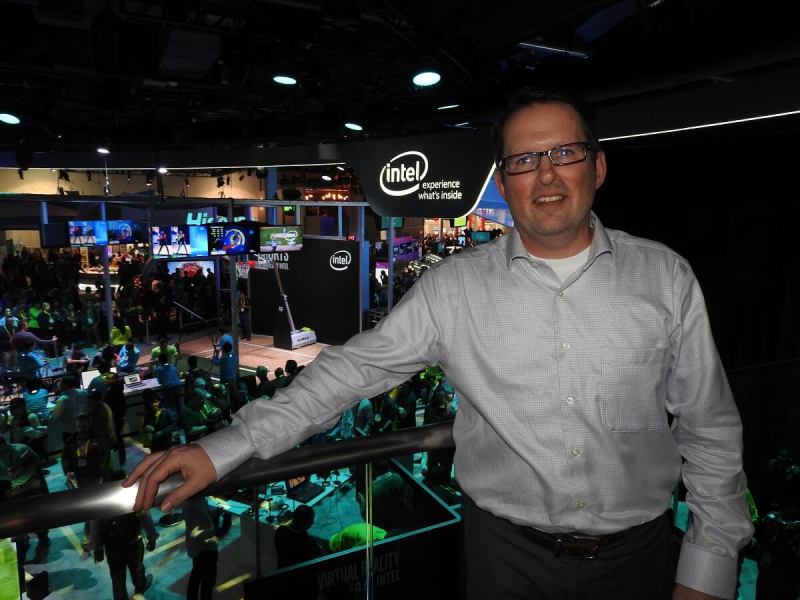The Internet of Things is expected to grow quickly to tens of billions of connected devices, from smart refrigerators to smart showers to smart cruise ships. Pretty soon, it’s going to extend to smart cars, as Intel demonstrated at its recent autonomous cars event in San Jose, Calif.
But Intel knows that we’ll have to get data in and out of those cars at rates that are much faster than today’s LTE mobile networks can handle. And that’s why Rob Topol, general manager of Intel’s 5G business and technology, believes that 5G wireless networking will be like the “oxygen” for self-driving cars.
Intel is making 5G modem chips to transfer data at gigabits a second over wireless networks in the future, perhaps as early as 2020. Topol believes this wireless networking will enable self-driving cars to communicate with connected infrastructure. That infrastructure will help the cars process sensor, safety, and other information for the car and return the results quickly to the cars.
“What we were showing with that demonstration is a capability called V-to-X — vehicle to infrastructure, vehicle to pedestrian, or vehicle to vehicle,” Topol said. “You’re utilizing the other objects and using a network to give the car vision beyond things it can’t see through the mechanisms in the car itself — something that’s happening around the corner or further ahead.”
June 5th: The AI Audit in NYC
Join us next week in NYC to engage with top executive leaders, delving into strategies for auditing AI models to ensure fairness, optimal performance, and ethical compliance across diverse organizations. Secure your attendance for this exclusive invite-only event.
We talked about 5G and its connection to autonomous driving in a recent interview. Here’s an edited transcript of our talk.

Above: Rob Topol, general manager of the 5G business at Intel.
VB: Where are we on the timeline for 5G?
Rob Topol: As you’ve seen, there’s been lot of work going on in 5G over about the last year and a half. It started with developing the air interface, how it works between the device and the core access network. It starts with the trial specifications we’ve been doing, where you try out different things like modulation or channel coding, essentially building this new radio.
The timeline is that you do many of those trial specifications over about a year to two years. All that work you do in the field, testing with partners and building a recipe, you take them to the standards bodies and submit them as contributions. Intel and other companies will submit their ideas and say, “This is what we think the standard should be based on.” The voting happens in 3GPP from a cellular standpoint, with the first round later this year. In December, the New Radio, or NR specification, will be set, and the full release for 5G happens in Q3 of 2018.
Once the NR spec is set, that’s when you’ll start to see development around the modems, around the networking equipment to support that. Full release 15 is at greenlight. That’s when you see the Capex orders come in from network operators to the infrastructure companies. Intel puts its chipset designs into production. You start to see some operators roll out networks as early as 2019. You’ll probably see most do them around 2020. Typically, once the full release is done, it’s about 18 months until you start to see the networks deployed in a broader way.
VB: How do you help people get an appreciation for how important this is? What’s at stake? What will people get out of it?
Topol: We focus on the things that 5G is about that 4G was not, if that makes sense. 4G was the era of the smartphone — data proliferation, access to media, mobility in general, with something in your pocket. 5G is an era beyond the smartphone. Over the next five to 10 years, we have billions of connected things coming up all around us. As we make everything from a refrigerator to a car to a home to an enterprise network smarter, the compute that’s happening—more data is sent through a network, whether to help improve the service model or the user experience of those things, or to harvest that data for machine learning and data analytics, any sort of behavior or artificial intelligence work.
We look at 5G as the platform that helps all of those other verticals grow. We see some of the early use case research. We see a lot of promise for 5G in automotive. We see a lot of promise for smart home and enterprise, if you move networks more to a fixed wireless capability. Not just relying on fiber and other LAN connections. We’re also looking at industrial automation. We have a few projects in that space, helping get a lot of that incubation going. What does a connected factory mean? How does it operate? How would a factory benefit in productivity, in the way machines are set up and run and optimized, when the factory is connected? What capability does that bring?
How do we help people with that vision? We show as many of those use cases as early as we can. We go out and showcase with automotive companies, showing them 5G in a car, so they can see the way data comes into the car for the way it functions, for safety, and more important for bandwidth, the way our experience inside the car is going to change when it’s autonomous. When you’re sitting in the back seat of that car, your experience changes. You’re not required to be fully focused on where it’s going and what it’s doing. The bandwidth requirements in the car are going to grow exponentially as our time is freed up inside the vehicle.
We do the same thing in industrial automation. We set up a partnership with GE and Honeywell and Ericsson called the 5G Innovators Initiative. We’re blueprinting what we think the factory of the future could and should look like, how it would operate. We try to give people that vision. We’ll do that for how drones are used. We’ll do it for fixed wireless in home and enterprise. We’ll do it for media and viewing experience. We’re working with media companies to look at the way media is captured and how it’s transmitted and how it’s consumed. That’s another major focus area of that initiative.

Above: Intel is moving fast into autonomous cars.
VB: I’ve seen different kinds of reports about how big 5G is going to be as a contributor to the global economy. What do you think about that? Is this going to transform society?
Topol: It opens new business models. As you talk about a smarter city, or a more efficient factory, or a vehicle that can run autonomously, it does change our behaviors, our habits, and what we can do with our time. I’d agree that 5G will open up many new business opportunities, primarily because of the data that’s coming off these smart and connected machines all around us. The ability to analyze, compute, and harvest that data is going to make us smarter in the way we lay out cities, set up factories, drive cars, and do other things around us.
There’s a tremendous opportunity. I don’t have a specific study we’ve done yet. Our focus is to deliver the technology baseline and the use cases around it. We’re confident that our partners are going to build great business models around it.
Our strategy from the start, as we said at CES, is end-to-end capability. Intel is the only company that sells hardware solutions from the device all the way up through the core and access networks and into the cloud and data center. Our ability to build out that new vertical for a partner – to sit down with GE or Honeywell or a media company and show how that blueprint works in 5G – is a very compelling case for Intel. We can do very quick testing and prototyping and move to commercial solutions. That’s part of why we have the partners coming in and working with us that we do. It’s a big part of our strategy.

Above: Intel and Ericsson achieve first pre-5G over-the-air wireless interoperability between the 5G Intel Mobile Trial Platform UE and the Ericsson 5G Radio Prototype system.
VB: We talked before about how, in some ways, 5G and the bandwidth it brings could allow a shift in where computing happens. If you need it to happen in the cloud, it can happen there, or it can happen at the edge. But then the expansion of demand for that particular bandwidth, at least in the case of 4G, caused the networks to bog down again. Once everyone was able to watch video on their smartphones, they did it, and that brought down the quality of voice traffic on the networks.
Topol: Exactly. There are two or three ways we want to address and mitigate that. The first is to have a strong advocacy position around spectrum. There’s more spectrum out there to be used for these communication types. Opening up more spectrum in the lower frequencies, below 6Ghz, but also opening up—a lot of the prototyping we’re doing in millimeter-wave is to open up that additional bandwidth via spectrum allocation. We’re strong advocates of that globally. We drive, through many of the advocacy groups, that harmonization, trying to have certain parts of millimeter-wave, certain spectrum in sub-6Ghz, be harmonized globally. It’s easier, from a design standpoint, for our radios, and it’s also just a better experience for consumers to transcend between those locations.
The second is offloading what is actually going up through the networks. We talked a bit last time about machine to machine communication. A big part of 5G protocol is not only to make a fatter pipe and higher broadband connection, but to allow more machine to machine communication, where those machines don’t need to communicate up through that local access point or base station. They can communicate directly with each other. That’s a significant offload for those networks.
The third is some of the network transformation technologies that Intel is pioneering. One is mobile edge compute, where it’s putting more of the caching and content at the edge of the network. It’s not something that has to go all the way back through an access network and into the cloud to access and retrieve that. A lot of content can be carried closer on the edge of the network.
Another one is network slicing. With 5G, when you move to a software-defined network, you can slice the business model or the vertical. With automotive, you can slice the way the vehicles connect to base stations and cell towers and up through the network. You can essentially quarantine it from driving by a busy university campus with hundreds of college kids streaming and downloading media, or any other activities that constrain a network. You don’t want that to affect the safety functionality of cars, or the reliability a connected factory might need. Network slicing is pretty critical.
Think of it as spectrum allocation, having these network transformation technologies, as well as offloading a lot of communication and keeping it at a local, machine to machine level.

